.jpg)
White Pass & Yukon Route Railway, Skagway, Alaska, 1994
Trains
As a child in England, I was an enthusiastic trainspotter. No, I wasn’t an adolescent junky; I was addicted to the wonders of steam trains.* My friends and I would go down, ABC guide in hand, to meet arrivals under the Victorian, soot-stained glass of Wolverhampton train station.
The objective was to underline in the guide numbers of listed trains we’d seen. The ultimate coup, signified by two lines under a listing, was to “cab” a train — that is, to be invited by the engineer into the cab of an engine to look in awe at levers, dials, pipes and pressure gauges, better yet to be allowed to throw a shovel of coal into the glowing red maw of the furnace.
Occasionally, I’ll smell something that reminds me of the acrid pong of a steam train and I’m on a British Railways excursion to Rhyl, head out the window, watching puffs of grey smoke arcing back along the cars, or curled sleepily on musty seats, happy as a lark.
For a while, I lived in White Rock, British Columbia, in an apartment overlooking the waterfront railway line on Semiahmoo Bay. One day I snapped a photo of the Royal Hudson 2860 chugging by, as memory says it occasionally did.
Strangely, online historical summaries omit this fact, commenting only on its resurrection by the NDP government in 1974, to run as a tourist attraction between North Vancouver and Squamish, visiting White Rock only later, in the ‘80s and ‘90s.
.jpg)
Royal Hudson, White Rock, 1977
Nevertheless, here’s my photographic evidence (no Photoshop hijinks!) that the grand old machine rolled through the town in 1977.
The last time I boarded a steam train was in 1984. As mentioned in one of my Cambie Street Bridge stories, I got on as an extra in the Disney movie The Journey of Natty Gann, because I have what is known in Hollywood as a “character face.” After the first day’s shoot — a cold, rainy November day in a Potemkin hobo camp under New Westminster’s Patullo Bridge — the casting director marked my card with an endorsement that won me another day on set and encouragement that my mug could at least help launch an aging locomotive.
Crew and cast, including child star Meredith Salenger and a young (not to mention brooding) John Cusack, assembled at the BC Rail Station in North Vancouver to board not the Royal Hudson, but a vintage 2-6-2 prairie class locomotive. That the 1077 was built in 1923 to serve logging operations on Vancouver Island seemed appropriate, since Natty’s ultimate destination was a Pacific Northwest logging camp, in search of her father.
Like Depression-era itinerants we “rode the rod,” at least as far as Squamish. Unlike our real-life counterparts, our bellies were filled with grilled salmon and an array of gourmet nosh at an opulent buffet laid out at Britannia Beach. The RCMP did not fire a single shot our way.
As I discovered researching this post, the 1077 is now the main attraction at Fort Steele Historic Site in the Columbia Valley, just south of my old mountain hideaway in the Kootenays.
While petroleum-powered trains may not inspire the romance of their coal- and wood-burning predecessors, and I do not care for the smell of diesel, not so long ago they provided a cheap and cheerful means of long-distance travel in Canada.
I used them to flee Prairie and Ontario winters across the Great White Land.
Clackity-clack, clackity-clack, you broke my heart and I won’t come back.
Entering the Fraser Canyon, the fragrant sea, albeit with a hint of diesel fumes, announced that I was home.
I often hopped a train from the west coast to the Rockies. I recall the fare being somewhere around $35, back in the ‘80s. How can I forget fleeting romances in the dome car?
The BC Rail train running between North Vancouver and Prince George, with stops in Squamish, Pemberton, and Lillooet, took me on many adventures to hike, climb and cycle in the Coast Range. The operation was liquidated in a shady deal by the ruling Liberal Party in 2003, leading to an RCMP raid on the provincial parliament buildings and a lengthy court case that amazingly saw no one do time. “Railgate,” the affair was dubbed. Of course, taxpayers shelled out for the lawyers.
.jpg)
Crossing Barcley Sound, 1989
Boats
My experience with boats also began in England. My grandfather, a veteran of the British Merchant Navy with stories of wild storms on the high seas and the scars to prove it (his hand once pierced-through by a grappling hook), took me on ferry trips to Wales and taught me to row on the pond at Wolverhampton’s West Park. He waxed poetic about the Cutty Sark, the great British clipper ship.
One of my earliest, and most vivid, memories is seeing my nan off from Liverpool docks on a trip to Canada aboard a great, black-hulled Cunard liner. The bottomless green water below the jetty gave me the willies.
Despite Granddad’s nautical narratives, I was pretty much a landlubber, aside from the odd fishing trip after emigrating to Canada, until I took up ocean kayaking in the 1980s. It was then, a decade after his passing, that I felt his guiding hand, gnarled by age and labour, steadying my paddle on sketchy crossings on the outer coast of Vancouver Island.
During my years in Toronto, I took my first turn at the tiller of a fellow photographer’s sailboat, sails filled with the winds of Georgian Bay.
Beginning in the nineties, I joined friends, including old climbing and kayaking partner Tom Hocking, on sailing trips around the Gulf Islands and Desolation Sound — gunkholing as they call it.
Small and nimble in those days, I graduated to the racing set, in particular to crew on Nigel Philcox’s Thunderbird, Valkyrie, up and down Vancouver Island. Nigel and his siblings had grown up on eastern Vancouver Island with the waters off Cedar by the Sea as their back yard. We once won the Thetis Island Regatta — not just our class, but the whole race — because Nigel’s brother Tim, a fisher by trade, knew the local currents so well. When the wind dropped in the final minutes of the race, we sailed by the becalmed fleet, grinning like Cheshire cats.
I can highly recommend this approach to sailing: have friends buy the boats. All that’s required is an occasional donation of barnacle-scraping labour and the odd bottle of rum.
.jpg)
Rain on Plane, 2016
Planes
Here’s another mode of transportation with which I can’t claim any great familiarity. I can count on my fingers the number of times I have flown the friendly skies. Well, I might add a few toes to the calculation.
Nor is it my favourite way to travel. My grandfather thought it completely unnatural and, as a result, only came to visit Canada a couple of years before he died.
Meanwhile, old climbing buddy Frank Wieler has flown in a Russian MiG-29 to the edge of space and piloted planes in faux combat over California, pulling major Gs and loopy evasion maneuvers, if I have the lingo right.
I’m gobsmacked by such accomplishments. Frank has an obsession with all things spacey. He has met men who walked on the moon. I didn’t realize all those times we stood on alpine summits, Frank wanted to continue skyward. He went on to paraglide in the Alps and, as I said, view the black arc of space from 70,000 feet.
Considering I live in a mecca of bush pilots and the storied de Havilland Beaver, I’ve spent little time in small aircraft. If I can add helicopters to the list, I’ve still got digits to spare. Despite my fear of flying, I do get a kick out of cruising above the planet. It certainly gives one an appreciation of its wonders, and the damage humans can inflict on its dermis.
My archive, as such, of aerial photography is limited to snapshots from the cabins of DC-8 (on which I arrived in Canada in 1965 and made my first return visit 23-years-later) 737, and the odd Airbus. My filing cabinets contain a few rolls of film exposed on Cessna- and Bell-assisted shoots over the mountains of Yukon and BC. I admire masters of this genre, like William Garnett and Bradford Washburn.
Caboose
No surprise that my favourite way to travel, other than by foot and bicycle, is by train — it is relaxing and leisurely. Unlike plane travel, it is comfortable. Even if one can’t afford a bunk, there’s always the bar car to meet fellow travellers and exchange lies over a beer, or retreat to the dimly-lit dome car to watch the outlines of mountain peaks drift by.
But wait … the days of cheap Canadian train travel are over. A 2-day ticket on “The Rocky Mountaineer” tourist train will set you back $1700CA. It’s out of this world, not to mention the reach of the average wage-earner.
By comparison, the British and European train systems, though by no means cheap to use, are an integral part of the public transportation system. I enjoy using them.
But in between, there’s that long plane journey.
*The infamous film about Edinburgh heroin addicts has supplanted any mention of the once-common hobby via search engines. To return any info on the original innocent meaning, try typing “trainspotting hobby.”















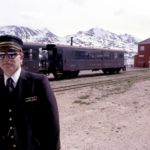
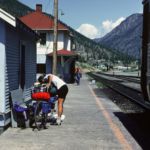
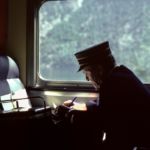
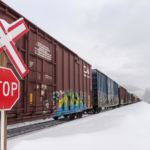
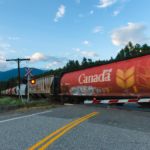
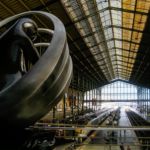
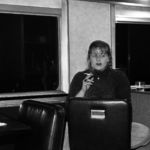
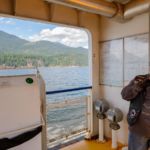
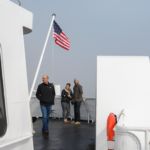
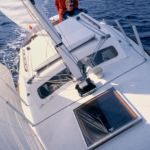
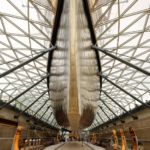
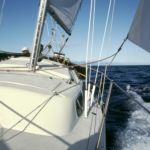
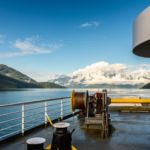
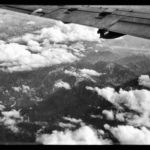
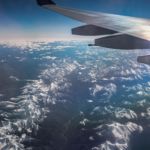
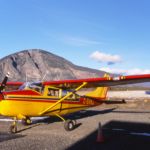
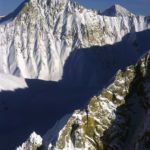
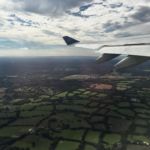
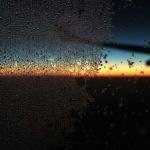
Jim - I love to paddle a canoe. Combined with a hike between lakes. A great camera platform and a way to see the world that is very different from car or bike. I also have fond memories of car trips from child hood, exploring the coast of Lake Superior and the woods, on long camping trips. The Photo of the Royal Hudson has a wonderful feel above. PS Float planes are fun too. October 12, 2017 – 10:53 am
Raymond Parker - I’ve never been on a float plane. Certainly photographed a few. During my sojourn in Toronto as an advertising photographer, as mentioned above, I also did a couple of canoeing trips … to Killarney Provincial Park as I recall. I do remember clearly the portages in humid, tropical heat so enervating that one couple quit at the first haul-out. 🙂
The Royal Hudson image is a scan of a faded and stained 3×6 print, with colour correction to take out the yellow. I have misplaced the negative.October 12, 2017 – 11:30 am
Susan Carrick - dad was in the air force early 50’s and transferred around the country a lot….lots of train transport which was fun in the sleeper car (got the upper berth to myself!), and also one transfer on a Hercules. Very daunting at a young age! Father in law was Chief Engineer in the Merchant Marine in WW2 and sure had the stories to tell. Thank you for continuing to share your amazing travels and your workOctober 10, 2017 – 9:35 am
Raymond Parker - And thanks very much for your anecdotes and accolades! 🙂October 10, 2017 – 7:21 pm
Conor Ahern - What a bit of coincidence my father was in the Irish Merchant Navy after WW2, during the War, or “Emergency” as it was known in Ireland, he served on a mine sweeper around the Irish coast. Many was the time he would regale us with sea faring tales, the one we all still talk about is the North Sea “where the shots would be frozen in your nose and the water would be running out of your pockets.” There have been times in the 33 years since his death where I have had water borne misadventures, where it seems that some guiding hand has put me on the path to safety.September 27, 2017 – 2:22 pm
Raymond Parker - Yup, as Granddad told it, it could be pretty grim. Hard labour and harsh conditions. I’m guessing the “h” key is close to the “n” key, rather than your Dad actually firing the contents of his nose at the enemy, Monty Python-style. 🙂
Incidentally, my granddad loved the Irish.September 27, 2017 – 3:29 pm
Amanda - This is a great story, and love the photos with it.September 27, 2017 – 10:47 am
Raymond Parker - Glad you liked it/them, Amanda.September 27, 2017 – 2:09 pm